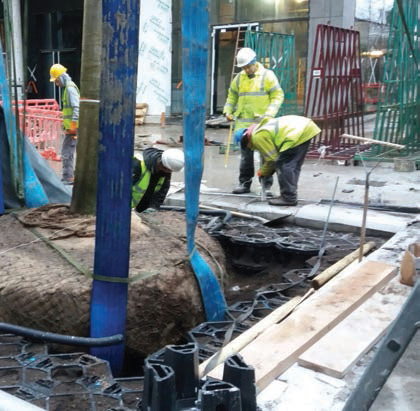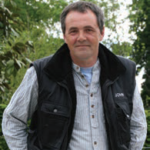John Murphy, owner, and operator of Annaveigh Plants digs below the surface to reveal why trees thrive or die in urban situations
While flying into Hamburg last week to select stock, my client commented on the tree coverage in the city, an observation I often hear when visiting other European cities. This is usually followed by, “Look how close the trees are to the houses,” and once out into the small villages, “Look how much they use plants and trees right up to the house.”
I think the root of the problem is our fear of damage to our own private houses and buildings, and for the public and corporate sectors, one can add the fear of litigation. I am sure in the Georgian period when planting some of our best-known city parks they didn’t have to contend with practices that divert tree roots or worry about litigation if the trees fell on passing carriages.
The perceived threat of damage by roots is sometimes a worry people have about trees near buildings. Much of this concern is unwarranted as most trees growing near buildings cause no damage. Residents may also feel apprehensive about the size of a tree and consider it dangerous. However, trees are not dangerous just because they are perceived as tall, too big for their surroundings or move in the wind. Tree movement in high winds is natural and one of the ways they are able to withstand strong winds. Proper root development in the early production stage and subsequent use of the right planting pits and materials will greatly reduce any possible damage.
With this in mind, let’s explore some of the root issues to be considered when choosing trees. As a grower, I have always encouraged clients to get to know the tree nurseries they are using. Visit them at least once a year and see the growing practices and after a short time, you will know if proper cultural methods are being used. If you are specifying trees ask the nursery for options and use the knowledge they have. For example, standard pines have come very much into vogue recently and to ensure their success in the landscape they must at no time have been pot grown unless in root trainers. Once pine roots have circled the pot they will never develop a root structure to support the crown (I learned this the hard way when we lost over 200 pines in a winter storm with our first crop of standards). This also applies to many tap rooting trees, so talk to the nursery beforehand and ask their advice.

The obvious consideration when it comes to roots is the transplant history of the tree. The trees I went to mark last week were 7080cm girth pines for a planting project in 2022 and must have a considerable percentage of the roots within the 2.5m diameter of the stem – the size of the rootball. To achieve this, these pines were transplanted nine times and are now 32 years old. Whether your project requires 32-year-old pines or small transplants, careful consideration should be given to the roots. For any standard tree planting on a landscape site, the minimum specification should be for three times transplanted trees up to 18cm girth, and four times for trees up to 30cm girth.
While multiple transplanted trees can give rise to the request for smaller rootballs to fit into the paving design or to reduce the weight stresses on podium planting it’s a better practice to consider the trees’ requirements. Before tree pits are specified always consider the correct rootball for the girth size required. I can’t remember how many times we have lifted and delivered trees only to be contacted to say that the pits specified are too small. This has also happened after importing trees of considerable girth and expense to everyone. The next time you are selecting trees, check with the nursery first and design the pit to suit the tree size.

Choosing the right tree for the right place would be an article in itself so when it comes to roots a few considerations have to be taken into account. Tolerance to salt-laden spray from roadways needs to be thought about. Some tree roots such as those of the Corylus species are very sensitive to salt whereas Gleditsia triacanthos is very tolerant. For more information on this see the Dublin City Tree Strategy 2016-2020.
A common feature of older tree planting is that maturity can result in significant disruption of hard surfacing close to the trunk by large structural roots. While general rooting habit is an important factor to consider when selecting tree species, it will not in itself meet the problems of surface upheaval. A primary influencing factor of root architecture is soil profile and structure. As a result, root behaviour in urban environments can be quite different from that observed in natural, temperate forest settings. Planning for and providing ample, well oxygenated, void-rich growing medium for roots is one of the most important considerations in any comprehensive strategy for avoiding damage.
“Whether your project requires 32-year-old pines or small transplants, careful consideration should be given to the roots”
The next question is whether to rootball or not. We constantly see requests coming in for smaller and smaller rootballed trees. While I accept that it’s prudent to ask for rootballed Acer griseum 8-10cm girth I have another reaction when I have to quote for 10-12cm rootballed Acer campestre. A properly grown three times transplanted tree from 8-16cm girth can be specified bareroot with many varieties. We print a reference in our catalogue for further information on this topic. The extra energy used in lifting, transport and handling on site is wasted in many instances. I sometimes wonder when trees are unnecessarily specified rootballed, is it as a result of previous losses or as a hope to maybe negate the poor soil and aftercare on site.
So you now have a good relationship with the tree grower, you have the correct tree for the location. It has been transplanted adequately, has the correct rootball size and is ready for planting. Your next consideration for the roots is the soil.
In paved urban situations, it is best to use a soil mix specially developed for those locations. Soil compaction is one of the main reasons why tree roots do not thrive in urban street plantings and using proper soils in conjunction with tree cells and tree grills will avoid this problem. The photo above shows a 94cm girth Quercus palustris being lowered into a well-prepared tree pit. The filled tree cells are clearly visible and they will provide support for the paving and prevent compaction. They also allow the fibrous roots access to more quality substrate in the important years after planting. The irrigation fixings are discernible and in this case, moisture sensors were installed to control the irrigation.
Not every contract allows for such champagne treatment of the roots; in many cases, the contractor is faced with no more than hardcore. In those cases they need to excavate out a planting pit and refill with good soil but not before putting some drainage stone into the base of the pit, to help avoid it becoming a sump for water and killing the tree.
In the event where the contractor is presented with good soil, the addition of some organic material will help to aerate the soil and hold moisture in the all-important first season.
One other consideration for root development after planting is the use of mycorrhiza. These are symbiotic fungi that live with the tree’s roots extracting nutrients from the soil that the tree needs, in exchange for carbohydrates that the fungi need. I was always a bit skeptical about this until I had a road to Damascus type moment walking the dogs one evening. I had sowed a crop of green manure following an oak crop of 6-10cm girth. The crop was growing very well throughout the field but the plants growing on the oak ground were spectacular. This was borne out when I realised the green manure showed a significant reduction in growth where the previous oak crop ended half way down a line. These mycorrhizae are available in powder form and are well worth considering for root development in urban street planting, especially where made up soil has been used.

Before I finish I have to mention the H2o word. The lack of or the excess of water is the single largest killer of tree roots. Don’t plant in hollows or create a sump in poor conditions and remember, trees get thirsty and need a drink and not a sprinkle. Our attitude toward irrigation will have to change in Ireland. I would have been laughed at 30 years ago if I said I was irrigating the fields, nowadays we lay down the irrigation lines at the time of planting and have drilled five wells to meet demand. Irrigation needs to be incorporated on every landscape project, especially in city areas where rainfall is deflected by buildings and many plantings are in the shelter.
Apart from a drink, the roots need feeding. This is not a complicated process with all the different fertilisers available today. The best and easiest method is to use slow release plugs that are easy to handle and avoids having that half-used bag of fertiliser going hard in the back of the van. We use 18-6-12 + TE on the nursery and apply it two to three times a season depending on the rainfall and soil tests. When applying fertiliser keep it to the rootball area in the first year, and if you have time to take it seriously there is a new app that measures leaf colour and relates it to plant health. There are a few apps that do that job.
While we all concentrate on the visual aspect of the trees we plant, it is vitally important to focus on the roots if we want to achieve the same aerial views flying into Irish cities as I mentioned above. The photo on p41 shows a beautiful stand of Tillia in Berlin that have adequate pits for water catchment and aeration and the unseen cells prevent compaction. ✽
 JOHN MURPHY – owner and operator of Annaveigh Plants and is one of Ireland’s most experienced and respected nurserymen. For more information visit www.annaveigh.com JOHN MURPHY – owner and operator of Annaveigh Plants and is one of Ireland’s most experienced and respected nurserymen. For more information visit www.annaveigh.com |




